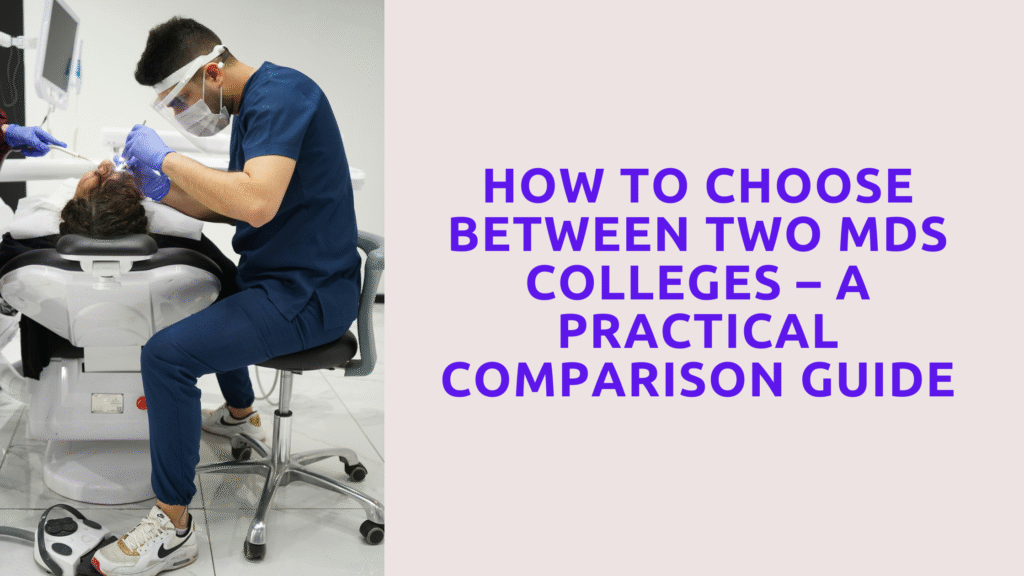After cracking NEET MDS, many students find themselves stuck choosing between two good colleges. Maybe both have similar ranks, or one has a great location while the other has a strong department. So, how do you make the best choice for your future?
This blog will walk you through a practical, step-by-step method to compare and select the right MDS college based on your personal and professional goals.
🧾 1. Department Strength Matters Most
✅ Ask yourself: What’s more important – the college or the department?
Choose the college that has:
- Strong faculty in your desired specialty
- Better surgical exposure or case diversity
- Access to advanced instruments and technologies
➡ Example: If College A is known for Oral Surgery and that’s your interest, it outweighs College B with a weaker department even if it has a better building.
💉 2. Clinical Exposure & Patient Flow
✅ Check which college has:
- Higher OPD (outpatient) numbers
- Diverse clinical cases and opportunities to assist/perform surgeries
- Active internship or postgrad hands-on experience
➡ Tip: Tier 2 cities often have more patient flow than private colleges in metro cities.
💰 3. Fee Structure & Stipend Comparison
- Government colleges usually offer low tuition + monthly stipend
- Private colleges may have high fees (₹8–15 lakh/year) with or without stipend
➡ Calculate total 3-year cost, then assess if stipend offsets the fee.
| Criteria | College A | College B |
|---|---|---|
| Tuition Fees | ₹10 Lakhs | ₹6 Lakhs |
| Stipend | ₹0 | ₹20,000/month |
| Hostel + Living | ₹1.5 Lakhs/year | ₹1.2 Lakhs/year |
Compare the total ROI (Return on Investment).
📍 4. Location and Lifestyle Considerations
✅ Ask yourself:
- Can you adjust to the climate, language, or culture?
- Is it far from home or in a high-cost metro area?
- Are there good libraries, hostels, or mentorship opportunities?
➡ Sometimes being close to home helps reduce cost and emotional stress.

🧑🎓 5. Bond, Rules & Post-MDS Opportunities
Check for:
- Service bond duration and penalty amount
- State posting rules (many states have rural service)
- PG teaching opportunities if you plan to go into academics
- Campus placements, alumni network, or linkages with hospitals
➡ Govt. colleges may have mandatory bonds, while some private colleges don’t.
📊 6. Talk to Current Students or Alumni
Speak directly with:
- Current PG students in your chosen department
- Recent alumni working in clinics or teaching
Ask them: - “How much hands-on experience do you get?”
- “Are faculty helpful?”
- “Would you choose the same college again?”
This first-hand feedback is more valuable than brochure claims.
✅ Final Decision-Making Checklist:
| Factors | College A | College B |
|---|---|---|
| Department Strength | ✅ | ❌ |
| Patient Exposure | ✅ | ✅ |
| Fees vs Stipend | ❌ | ✅ |
| Location & Living | ✅ | ❌ |
| Bond Rules | ✅ | ✅ |
| Alumni Feedback | ✅ | ❌ |
➡ Use this checklist to score and objectively compare your options.
📝 Conclusion
Choosing between two MDS colleges is not easy, but it’s a decision that impacts your next 3 years and your long-term career. Look beyond brand names — assess practical things like department quality, exposure, costs, and future prospects. The right choice will boost your confidence, skills, and success in dentistry.
🎁 Bonus:
Learn How to Grow your Clinic- Click Here
How to Choose MDS College Based on NEET Rank– Complete Tips– Know in details
